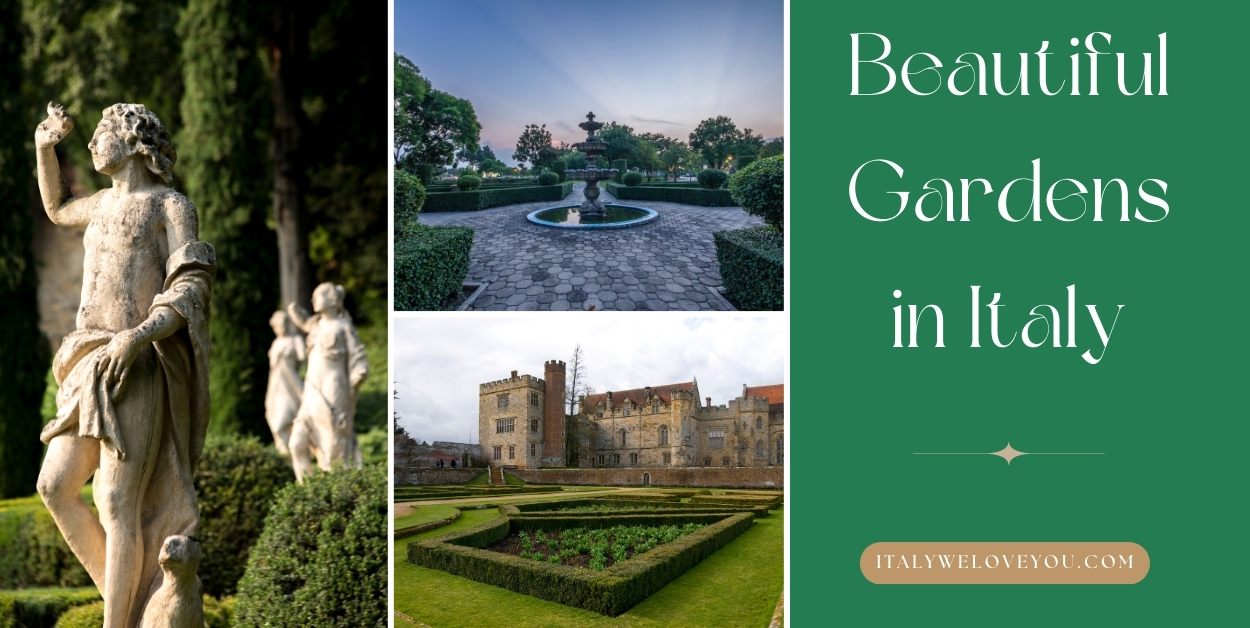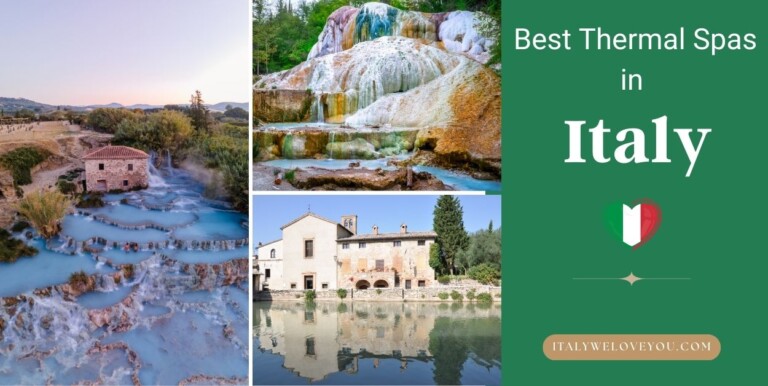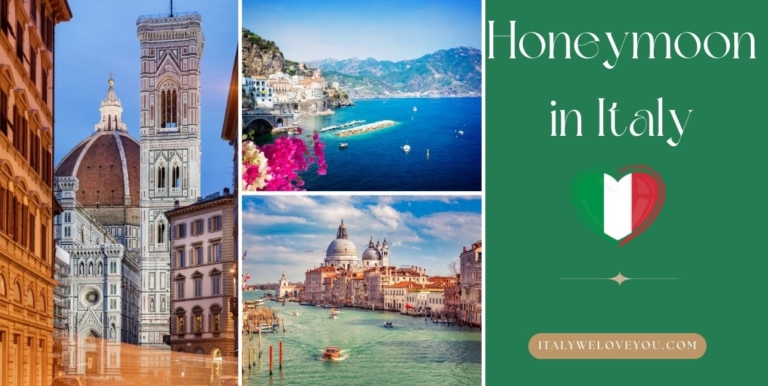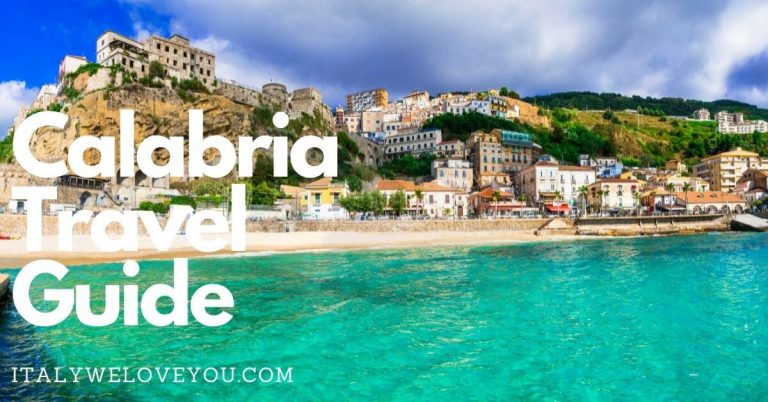13 Beautiful Gardens in Italy That You Must Visit
From north to south in Italy, elegant villas and public spaces have been equipped with wonderful gardens. This allows us today to immerse ourselves in unique landscape contexts in the world. Below we will take a journey through the most beautiful public and private parks and gardens in Italy, among centuries-old plants and trees, labyrinths, castles, and historic houses.
Villa Barbarigo – Galzignano Terme (Veneto)
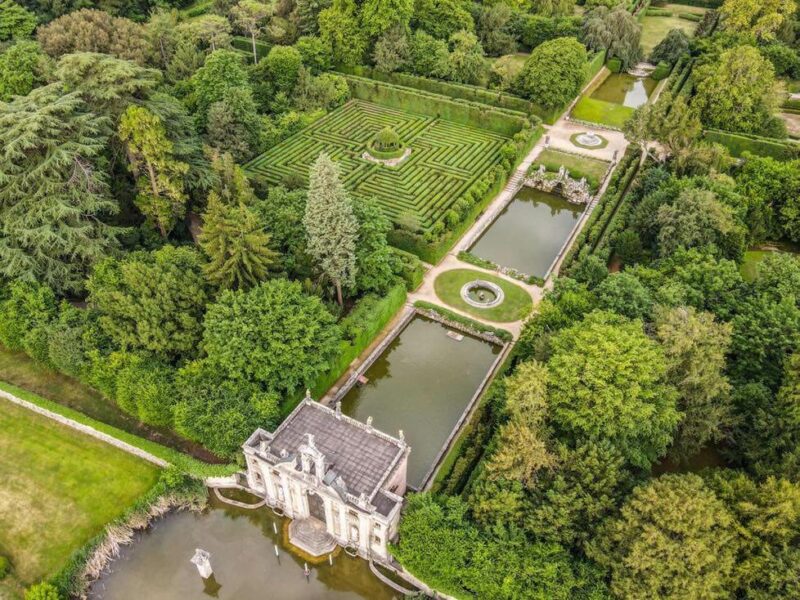
Villa Barbarigo is located in the province of Padua. The Venetian nobleman Francesco Zuane Barbarigo expanded the pre-existing building in 1619, transforming it into a villa. Here the architect Luigi Bernini conceived a wonderful green space, a symbol of seventeenth-century taste, complete with fountains, streams, small waterfalls, and a labyrinth.
The villa is a rare example of a seventeenth-century symbolic garden, which presents a complex system of fountains all working. More than a garden, it is a real park, with one hundred and fifty thousand square meters of land around the villa. There are about 120,000 plants, including several rather rare tree species.
The garden also contains over seventy statues and is crossed by paths that lead to the fountains (sixteen in all, including those of the Rivers, Aeolus, and the Winds), the boxwood labyrinth, ponds, fish ponds, streams and water features, to small buildings. The garden of the villa was recently awarded the international prize “The most beautiful garden in Europe.”
Trauttmansdorff – Merano (Trentino Alto-Adige)
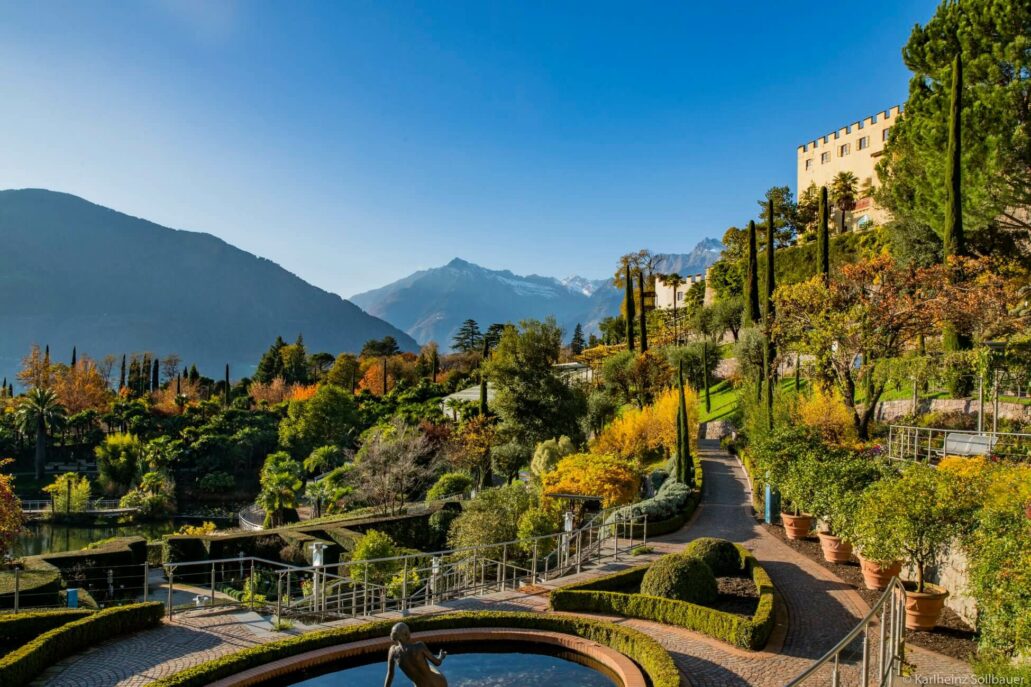
Another of the most spectacular gardens in Italy is the one that surrounds the Trauttmansdorff castle in Merano, in the province of Bolzano, amid mountain landscapes. This garden covers a terraced area of 120,000 m² and is made up of 80 botanical environments where1 plants from all over the world grow. Here plants and trees frame to the Tourism Museum, which shows the tourist evolution of the territories of Merano and Bolzano.
The Gardens of Trauttmansdorff Castle bring exotic and Mediterranean landscapes together in a natural amphitheater with breathtaking views of the surrounding mountains. Furthermore, the Gardens of Trauttmansdorff Castle fascinate for the enchanting intertwining of nature, culture, and art. Here you will find in fact several multisensory stations, suggestive themed gardens, artistic pavilions, and specimens of the animal kingdom.
At the center of the botanical garden is the Trauttmansdorff Castle, where Emperor Franz Joseph and his wife, Empress Sissi, once stayed and now houses a restaurant and the Tourism Museum.
Villa d’Este – Tivoli (Lazio)
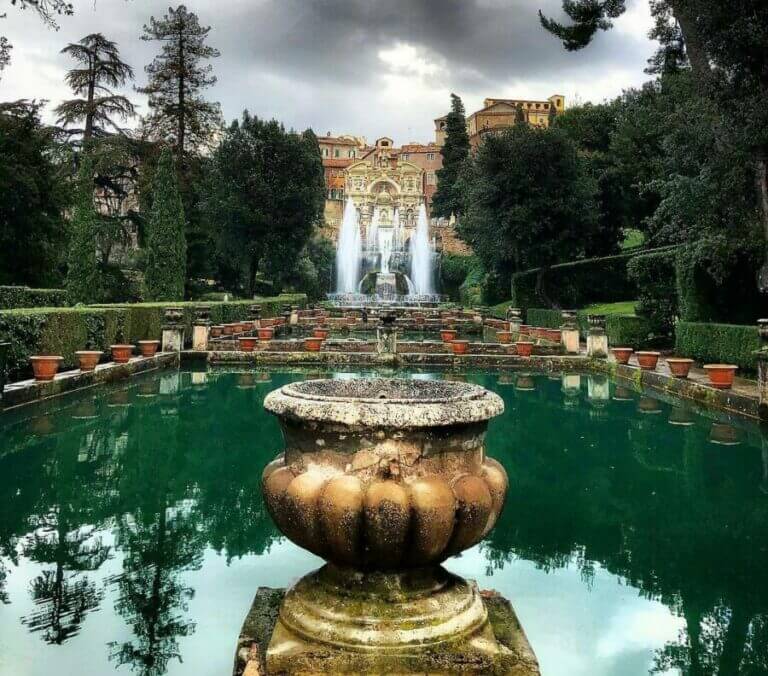
This Renaissance villa in Tivoli, just outside Rome, has been included in the Unesco World Heritage list with a wonderful example of an Italian garden. Cardinal Ippolito d’Este commissioned the villa in the 16th century on the remains of Villa Adriana, an ancient Roman residence. Among the spaces of which it is composed, there is a harmonious alternation of stone and vegetation, which also the presence of caves and streams of water.
The garden, the work of Pirro Ligorio, extends from the rear facade of the villa and is divided among terraces and slopes, connecting the different slopes of the garden using an architectural scheme typical of Roman cities. The garden is a triumph of fountains, two of which are by Bernini (the Bicchierone Fountain and the Organ Fountain Waterfall), capable of offering visitors unique water features. Villa d’Este has represented one of the most imitated models in European gardens thanks to its large concentration of fountains and streams.
Boboli Gardens– Florence (Tuscany)
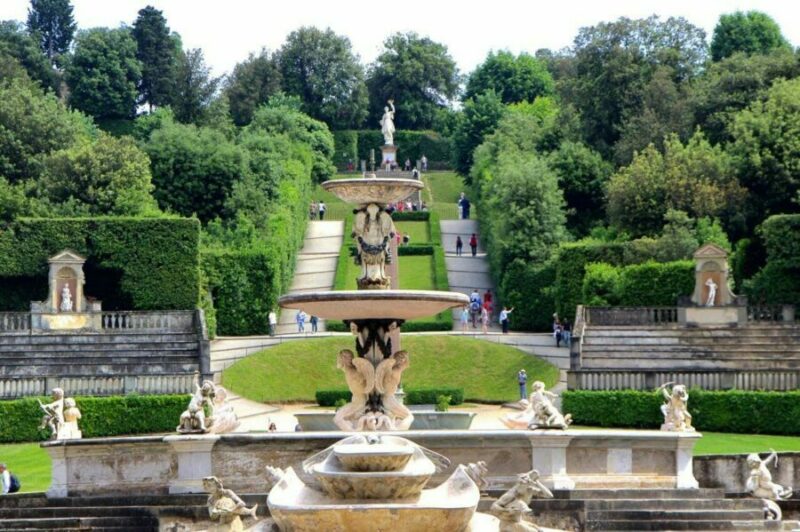
This huge park within the city of Florence (its surface measures 45,000 m²), was created by the will of the Medici behind the Pitti Palace. It is an example of an “Italian garden”. Along its paths, there are plants and trees of various species, numerous sculptures, and fountains (including that of Neptune), but also different types of architecture, which further enrich the charm of the park: the amphitheater, an Egyptian obelisk, the Grotto di Madama and the Kaffeehaus, an elegant Rococo style pavilion.
All this makes this place rich in history and culture. Boboli garden is divided into various sectors, such as the knight’s garden, the bird’s lawn, the pegasus lawn, the Madama garden, the garden of Jupiter, and others, each with its specific meaning.
Isola Bella – Stresa (Piedmont)
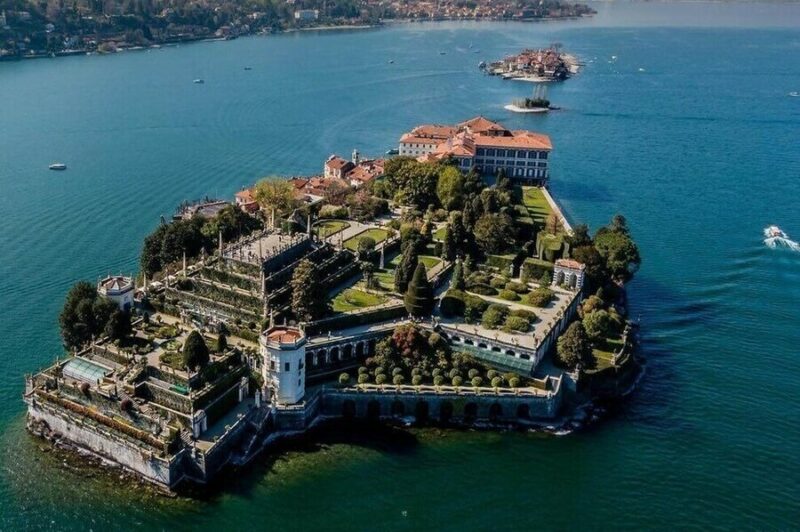
This harmonious island that lies on the waters of Lake Maggiore, in front of the beautiful town of Stresa, belongs to the group of the Borromean islands. Isola Bella (Beautiful Island) measures only 320 meters in length and 180 in length and is largely occupied by the wonderful Italian garden of the Borromeo Palace.
The seventeenth-century building, still owned by the Borromeo family, is surrounded by a magnificent Baroque garden. It was Vitaliano VI Borromeo, in 1632, who wanted to transform what was a bare spur of rock into a splendid palace with gardens of great splendor. He thought of this park as a real vessel in the waters of Lake Maggiore.
Also worth seeing is the Massimo Theater, the most important monument in the garden of Isola Bella, but also the statues, obelisks, and fountains perfectly integrated with the vegetation along the ten spectacular terraces, on the top of which stands the statue of the unicorn, symbol heraldic of the Borromeo family. All around the theater, a riot of blooms and rare plants.
Villa Taranto – Verbania (Piedmont)
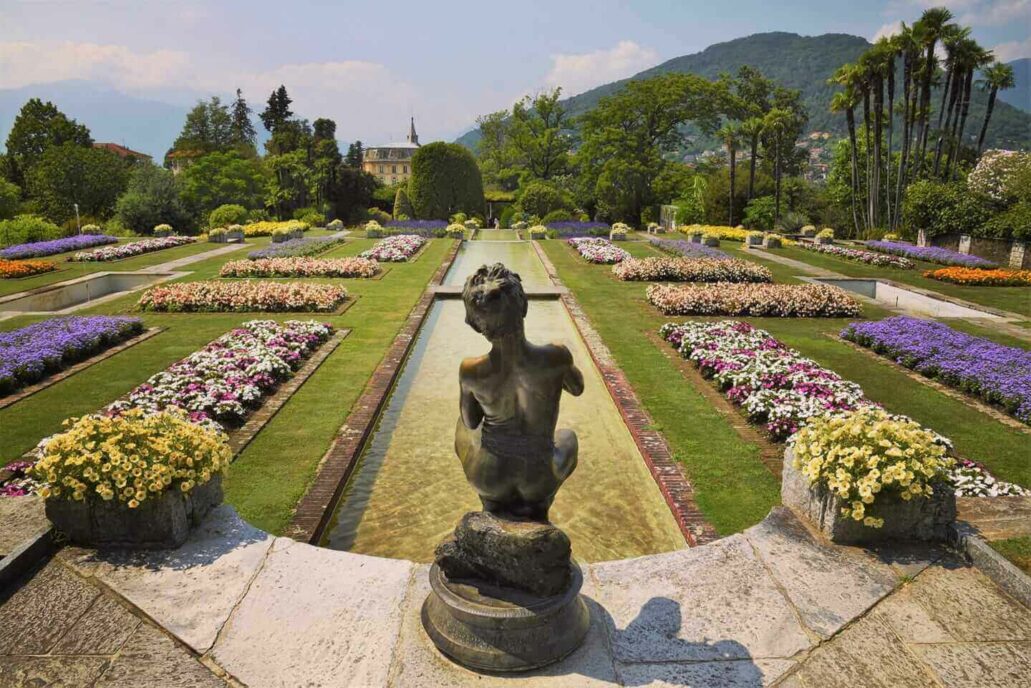
The Villa Taranto garden, considered among the most beautiful in the world, is located on the western shore of Lake Maggiore, near Verbania, in Piedmont. The terraced gardens of the villa host tens of thousands of plants, spread over an area of about 160,000 m² divided into multiple avenues, whose total length measures 7 km: a well-kept itinerary among the most beautiful floral examples that can be found in a garden.
The garden of Villa Taranto was created in 1931 by Captain Neil Boyd Watson McEacharn, a British soldier with a strong passion for botany and in love with Italy. The gardens are divided into various areas such as greenhouses, terraced gardens, flower beds, and herbaria. Different paths form the garden areas: from the avenue of conifers to the dahlie labyrinth, from the villa to the mausoleum and the greenhouse, from the fountain of the cherubs to the terraced gardens.
The species of vegetation present in the gardens of Villa Taranto come from all over the world. Entering the gardens of Villa Taranto is therefore like making a journey through distant Countries. In the garden, famous works of art in marble and bronze are also visible.
Ninfa Garden – Cisterna di Latina (Lazio)
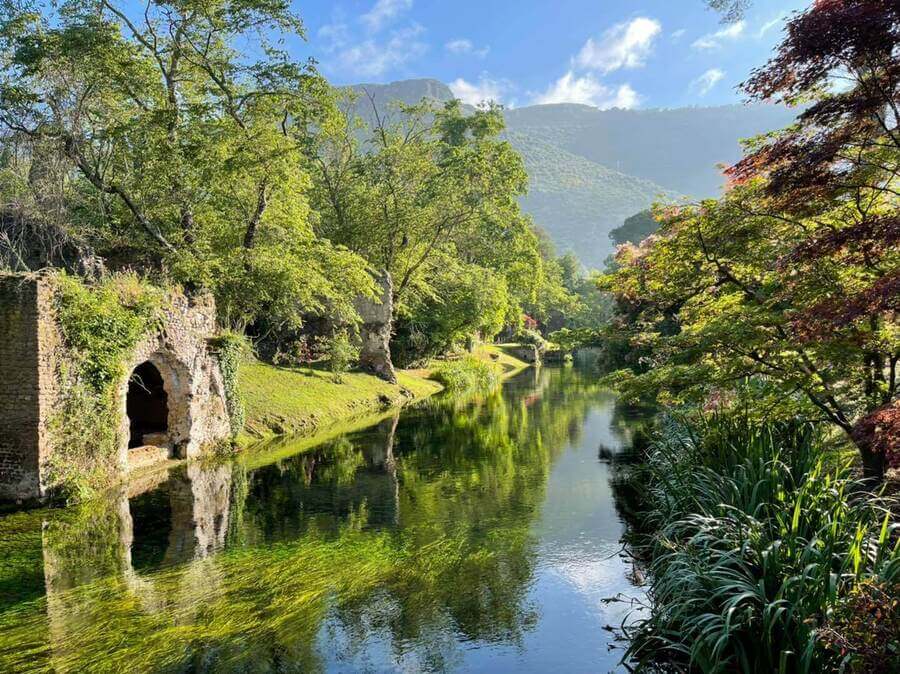
In Lazio, a fascinating garden is built on the ruins of the medieval town of Ninfa. The peculiarity of this garden, which covers an area of eight hectares, is that it stands on the ruins of an ancient medieval town, of which some can still be admired right inside the garden. This spectacular English garden hosts a great variety of floral specimens from all over the world, numerous streams, and the ruins of what was once the ancient town of Lazio.
Around the garden, since 1976, a WWF oasis has been established to protect local flora and fauna, and even in 2000, the whole area of Ninfa was declared a naturalistic monument. Today, the Garden of Ninfa is considered one of Italy’s most beautiful English gardens.
Strolling among ornamental flowering cherry and apple trees, magnolias, birches, marsh irises, and a sensational variety of Japanese maples is one of the most romantic experiences to have in spring. The garden, open only in certain periods, is visited by about fifty thousand tourists annually.
Sigurtà Park – Valeggio sul Mincio (Veneto)
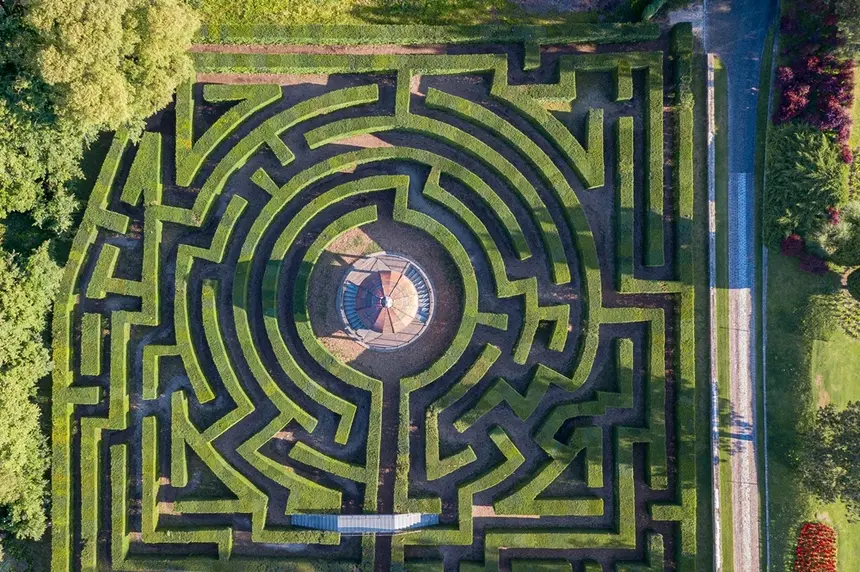
The Sigurtà garden park, located in Valeggio sul Mincio near Verona, enjoys two important awards; in 2013 it was proclaimed the most beautiful park in Italy and in 2015 the most beautiful park in Europe. The history of the park begins in the 15th century when the entire area was first purchased by a Venetian nobleman as agricultural land.
The aspect we can admire today is that of a large English garden, a project that started in 1941 when Dr. Sigurtà bought the land and diverted the waters of the Mincio, restoring fertility to the fields.
Today it is a public park of refined beauty, in which large manicured clearings are interspersed with groves, paths and Zen gardens, lying on the hills near Lake Garda. It covers an area of 600,000 m² and in this place, in spring, you can see many wonderful blooms: hyacinths, daffodils, and many tulips. It is the richest presence of tulips in Southern Europe and the most important in Italy.
The Sigurtà Park also cultivates various species of roses that can be found along a special avenue, as well as aquatic plants and a 2500 square meter hedge maze.
Miramare Castle Park – Trieste (Friuli Venezia Giulia)
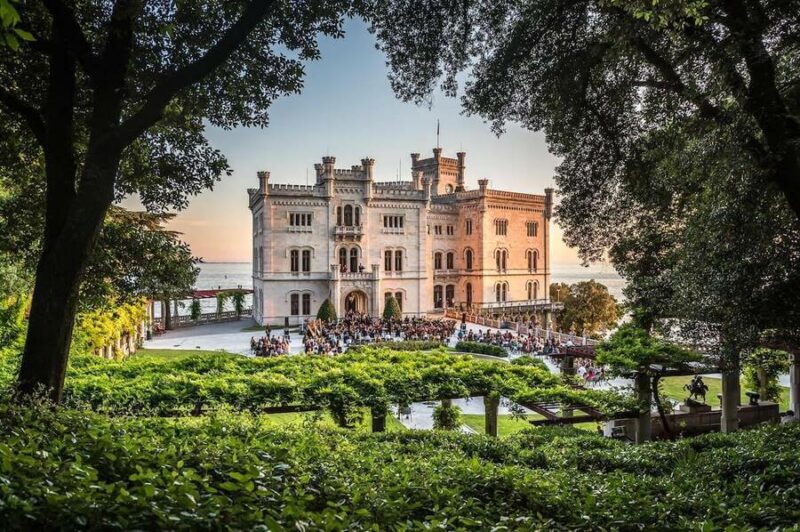
One of the most beautiful flower parks to admire in Italy is the large park around the Miramare castle in Trieste. This grandiose castle was the home of two important personalities, Ferdinando Massimiliano D’Asburgo-Lorena and the Archduke of Austria Federico V. The castle, an important historical building, is part of the Italian State museums, together with its park which extends over 220,000 m².
Overlooking the Gulf of Trieste, the park, with its enchanting castle, seems to have come out of a fairy tale. It contains many plants, vast grassy spaces, winding paths, and ponds, creating this splendid greenery corner. Inside you will also find the “Butterfly Garden”, a particular environment that allows 150 species of moths to live in this enchanting garden.
Most of the trees are native to foreign countries. In fact, you can see cedars of Lebanon, Spanish spruces, California cypresses, Asian pines, giant sequoias, and other types of plants of various kinds.
Villa Grock – Imperia (Liguria)
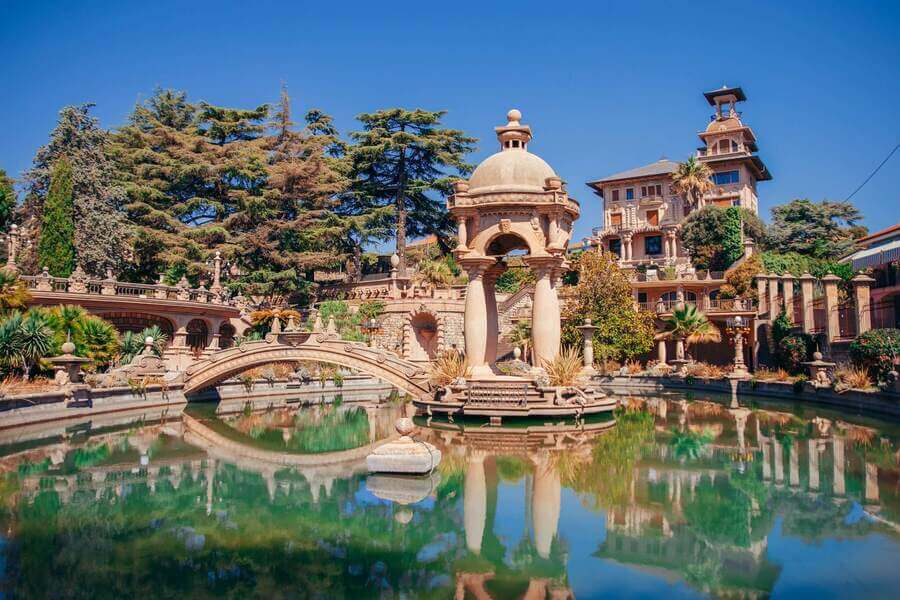
The beautiful Villa Grock is located in the hilly area of Imperia and has one of the most beautiful gardens in Italy. Also known as the “Museum of the Clown”, it is a magical and mysterious place wanted by a clown who came here to rest. It was built by the famous clown Adrien Wettach, stage name “Grock,” and is considered the greatest clown ever.
The villa is an incredible and extravagant architectural and decorative mix of rococo, liberty, art-decò, and oriental elements, all loaded with esoteric and Freemason symbolism. The vegetation of this place is composed of a vast typology of flowers and trees such as firs, palms, magnolias, cedars of Lebanon, olive trees. All around, you can admire sculptures and marble columns; through a small bridge, you can reach a singular temple island in the center of the park.
In the park of Villa Grock, fountains are built with a particular grit; you can also visit the museum, which houses objects related to circus activity.
Royal Palace – Caserta (Campania)
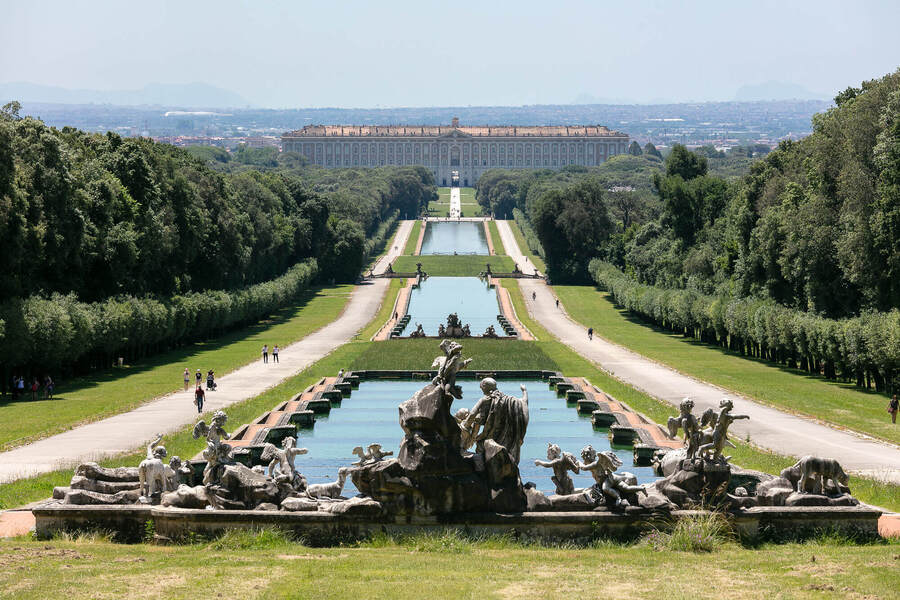
The Royal Palace and the Royal Park of Caserta were designed in the second half of the eighteenth century by the architect Luigi Vanvitelli at the behest of Charles of Bourbon and became one of the most beautiful residences in Europe.
Versailles inspired the architect for the entire complex, and, thanks to exemplary engineering solutions, he succeeded in equipping the park with water reserves capable of feeding the extension of greenery that leads to the Palace.
The 122-hectare park is a riot of greenery enriched by magnificent fountains and statues. Long avenues connect an Italian garden with an English one, fish tanks, and the triumphal Great Waterfall at the end of the park, further embellished by a mythological scene that seems to come alive under the eyes of the spectator: Diana, surrounded by some nymphs, is about to plunge into the waters while Actaeon, guilty of having dared to look at the Goddess in her nakedness, is already partially transformed into a deer; around him, the dogs are stirring, and they will tear him to pieces.
Proceeding north is the Peschiera Grande, an artificial lake with an islet where naval battles were simulated.
Villa Carlotta – Tremezzo (Lombardia)
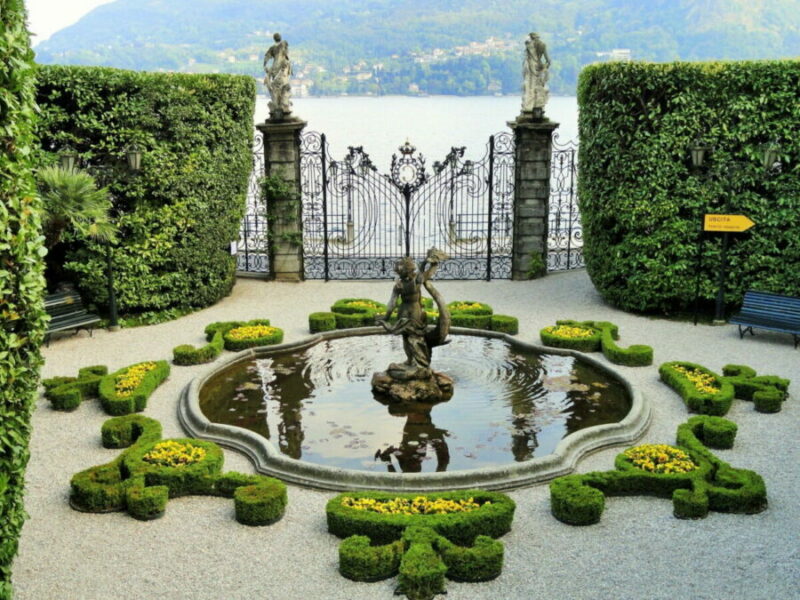
This villa overlooking Lake Como is known not only for the works of art it contains but also for its splendid garden. The town of Tremezzo is also located in one of the most beautiful spots on the lake.
The villa, built at the end of the seventeenth century, stands on the top of the beautiful and very rich garden, whose development is favored in flowering by the particular climate. The villa enjoys a fantastic view of the Bellagio peninsula and the lake’s mountains.
The garden also has great historical value. Here you can find citrus pergolas, camellia hedges, rhododendrons, many varieties of azaleas, cedars, southern ferns, tropical plants, palms, the garden of bamboo, and conifers. In the greenhouse, which is used in winter for citrus fruits, there is a remarkable museum of ancient agricultural tools.
The large Italian garden with tall geometric-cut hedges, parapets, statues, and water features remains from the seventeenth century; instead of the romantic period, the structure of the English garden is still visible, full of precious trees and very suggestive views.
Pralormo Castle – Pralormo (Piedmont)
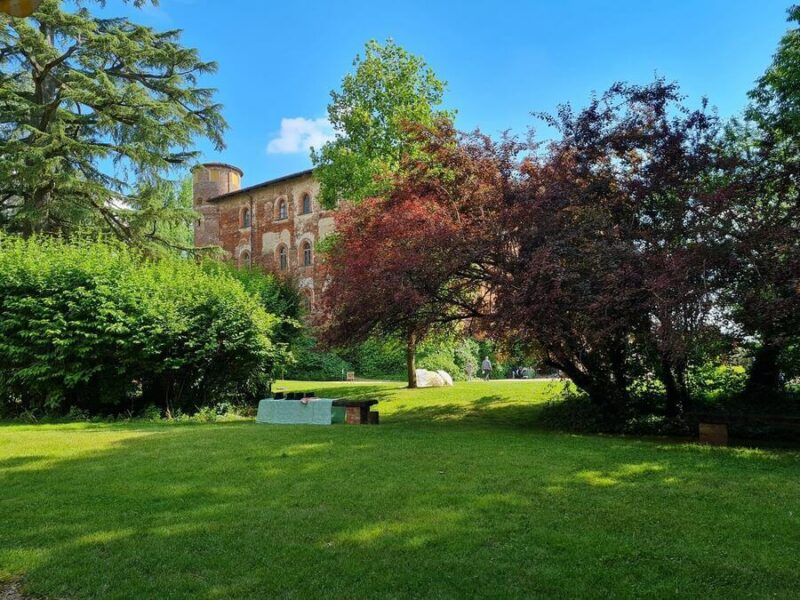
In the heart of Piedmont, between Turin and Alba, stands the medieval Castle of Pralormo, dating back to the thirteenth century. The castle boasts, in the month of April, the flowering of over 75,000 tulips and daffodils. The event is celebrated every year with the “Messer Tulipano” exhibition, which involves the entire town of Palermo.
Today the Castle is the home of the Counts of Pralormo, who open their doors to visitors to show the entire building: from the cellars to the large kitchens, passing through the stately halls, the Minister’s study, the music lounge, up to the third floor, guardian of a precious rarity: the collection of miniature trains that are the fruit of the passion that Count Edoardo Beraudo di Pralormo had since 1896 and for all his life.
The castle includes the park, the “Orangerie” (ancient greenhouse used for citrus fruits), the garden with flowers, the “Castellana” (imposing rural building), and the farm, still managed by the family also in order to preserve the surrounding landscape. From May to November, the Castle and its splendid park can be visited only on Sundays and public holidays.

